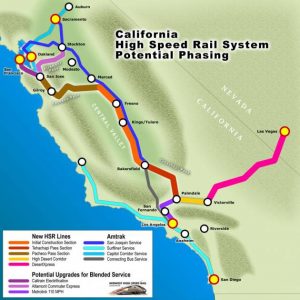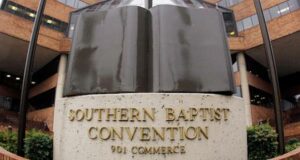What has already become known as California’s boondoggle, the high-speed rail project is reportedly getting even more pricey.
Eventually connecting 8 of the 10 largest cities in California, the project now faces billions of dollars in extra cost because of delays and inflation, according to Los Angeles Times.
Supporters said that upon completion, it would take less than 3 hours for people traveling from San Francisco to Los Angeles at the speed of 220 miles per hour.
 However, the project has spent an average of $3.1 million per day over the last year, and that will likely have to increase dramatically. The daily expenditure would have to reach $27 million in the next four years if the California High-Speed Rail Authority plans to complete the project in 2033 with a budget of $77 billion, reported Los Angeles Times.
However, the project has spent an average of $3.1 million per day over the last year, and that will likely have to increase dramatically. The daily expenditure would have to reach $27 million in the next four years if the California High-Speed Rail Authority plans to complete the project in 2033 with a budget of $77 billion, reported Los Angeles Times.
That’s an incredible cost say economists, with much of it coming from the Federal goernment which would be forced to generate those funds higher taxes on Californians and taking funding to other projects around the country like Kansas City’s light rail system.
I essence, the rest of the country gets to pay for the cost overruns for a badly-managed project.
Some of the problems stem from the state’s complex terrain, geology-related engineering problems, and outrageously expensive environmental reviews. In addition, buying land to build the track has proved challenging for the rail authority, as well as securing enough funding to continue the construction.
According to the report, if the project fails its deadline in 2033, its cost is likely to be raised $2 billion every year afterward, since all the postponed work would cost even more due to inflation and extended contracts with union only workers that received little oversight.
Two benefactors of the increased labor costs are the National and California Democrat Party organizations which gets more money in donations from Unions as more workers and more union hours are spent on the project.
The longer the delays the more donations come in though that wasn’t the plan.
“One of the things that this program has experienced, which has not been good, is consistently projecting things to happen by certain dates and it does not happen,” said rail authority board member Michael Rossi at a committee meeting.
At the same time, the cost of the project is subject to fluctuations in the price of labor, steel, concrete and the farmland that need to be purchased. Costs are rising so quickly that just in order to give an update on the project, every other year the California High-Speed Rail Authority issues a business plan.
The 2018 plan issued in June revealed that to finish phase 1 of the project, from San Francisco to Los Angeles, the highest estimated cost could reach $98.1 billion. However, even the current estimation of $77.3 billion is 20% higher than estimates in 2016 and more than double the project’s original price tag in 2008.
“When the voters of California approved Proposition 1A to fund this project, they thought they were approving a $33 billion project that would receive equal parts financing from the state, federal government, and private investors,” said Jeff Denham, Chairman of the House Subcommittee on Railroads, Pipelines, and Hazardous Materials, in a statement.
“However, since then, costs rose to $43 billion, and now the total cost is estimated up to $100 billion, but without immediate connections to San Diego or Sacramento.”
Phase 2 of the project includes extensions from San Francisco to Sacramento and from Los Angeles to San Diego, which has no cost projection as of yet. With the cost going up and the completion date being uncertain, some elected officials have started to question the project.
“If this project is going to move forward and the Authority is going to continue to ask for more taxpayer dollars,” said Denham, “we need to know what those funds or financing would be buying. If the Authority can’t provide specific deliverables and a timeframe, then I believe it would be time for Californians to go back to the polls to vote on whether to continue this project.”
–ETNews
 Metro Voice News Celebrating Faith, Family & Community
Metro Voice News Celebrating Faith, Family & Community 







